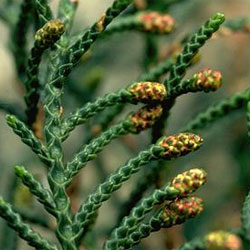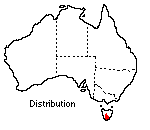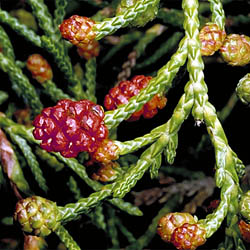Microcachrys tetragona
 male cones |
Creeping Pine
Microcachrys tetragona (Hook.) Hook.f.
Microcachrys tetragona or Creeping Pine, an attractive dwarf conifer
from Tasmania, has a low, creeping growth habit with straggling branches 40-100
cm long. As an ornamental it can be planted in a rockery setting and either
allowed to sprawl naturally among the rocks, or pruned back a little to give
a bushier effect. Alternatively it can be planted in a tall pot and allowed
to trail over the sides.
The foliage of Microcachrys tetragona is remarkably similar to Diselma archeri in appearance with tiny, thick, overlapping, scale-like leaves arranged in four rows along the branches giving a square cross-section to the stem.
This species, like Diselma archeri, is dioecious. The male cones are small inconspicuous structures, 2-3 mm long, borne on the ends of the branches. The ripe female seed cones, though only 6-8 mm long, are most conspicuous as the bract scales surrounding the seeds become fleshy and scarlet in colour. The seeds of this species are hard, brown, and produced on the upper surfaces of the cone scales.
Microcachrys tetragona grows best in a well-drained soil high in organic matter such as peat and requires plenty of water. Though it grows in full sun in its native Tasmania, the loss of plants at the Australian National Botanic Gardens during a very hot and dry summer suggests that light shade is more suitable at lower altitudes. As with Diselma archeri, this species is frost tolerant.
Although it is possible to raise plants from seed, these are often difficult to obtain as the small seed is shed rapidly by the plant and therefore proves difficult to collect. The easiest method of propagation is from cuttings taken in either spring or autumn, using 40-50 mm long semi-ripe tips of vigorous shoots, although older or harder material will also strike quite well. The cuttings are prepared by cleanly removing side branchlets from the base. They can then be inserted for one-half to two-thirds of their length in a rooting medium consisting of one part fine-grade peat moss to two parts coarse, washed river sand by volume.
The use of rooting hormones, misting or soil heating is not essential, though particular attention must be paid to adequate watering. At the Australian National Botanic Gardens, cuttings taken in autumn have rooted in four to five months with 90% success.
This species appears to be free from most garden pests and diseases.
Text by Stephen Hughes, ANBG (1981)
Name meaning: Microcachrys tetragonaMicrocachrys - of Greek origin meaning small bud or catkin, referring to the minute 2 mm male cones; tetragona - from the Greek, meaning four-angled. |
![An Australian Government Initiative [logo]](/images/austgovt_brown_90px.gif)


